FUNDAMENTALS OF CONDUCTION:
DIFFERENCE BETWEEN HEAT TRANSFER & THERMODYNAMICS
The main difference between thermodynamic analysis & heat transfer analysis of a problem is that in thermodynamics we deal with system in equilibrium i.e. to bring a system from one equilibrium state to another, how much heat is required (in Joules) is the main criteria in thermodynamics analysis.
But in heat transfer analysis, we evaluate at what rate that change of state occurs by calculating rate of heat transfer (in joule/sec or watt).
Modes of Heat Transfer:
(1) Conduction
(2) Convection
(3) Radiation
The thermal conductivity of gases increases with increase of their temperature. (The reason being the increase in molecular activity)
Liquids are better conductor than gases.
Example, kwater = 0.61 W/mk
Mercury (Liquid metal) is best-known conductor Liquid, kHg = 8.1 W/mk
Mercury has high thermal conductivity, Low vapour pressure & good expansion ability due to heat. Hence, it is used in a thermometer.
CONVECTION:
In case of forced convection heat transfer this macroscopic bulk motion of the fluid is provided by an external agency like far or a blower or a pump.
In case of free convection heat transfer, this motion is provided by buoyancy forces arising out of density changes of fluid due to its temperature change.
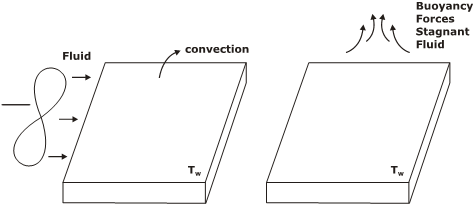
RADIATION:
Radiation mode of heat transfer predominates over conduction & convection particularly when the temperature difference is sufficiently high.
Example, Mode of heat transfer between hot flue gases & refractory brick walls in a large pulverized fuel fired power boiler is predominantly by Radiation.
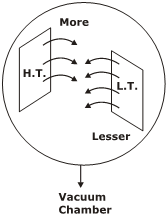


Fourier’s Law of Conduction:
The law states that “the rate of heat transfer by conduction in a given direction is directly proportional to the temperature gradient along that direction & is also directly proportional to the area of heat transfer lying perpendicular to the direction of heat transfer”.
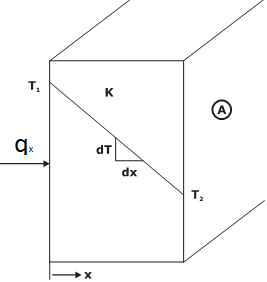
Heat always flows in the downhill of temperature (Clausius IInd statement of thermodynamics)
Thermal conductivity ‘k’ is defined as the ability of the material to allow the heat energy to get conducted through the material (W/mk)
Therefore,
‘k’ is thermal conductivity (thermo physical property) of material of slab.
GENERALISED CONDUCTION EQUATION:
Rectangular Unsteady, 3D heat conduction with Heat generation
Heat can be generated in a slab or in a material by passing electric or by exothermic chemical reaction or by thermonuclear fission reaction,

If conditions are steady, then
If there is no heat generation, then q = 0
Then this equation results into Laplace Equation:
Poisson’s equation:
Then this equation results into
THERMAL DIFFUSIVITY (α)
Defining thermal diffusivity (α), a thermo physical property of a material i.e., the ratio between thermal conductivity of material & its thermal capacity/heat capacity (heat storage capacity).
Thermal diffusivity (α) of a medium signifies the rate at which heat energy can diffuse through the medium. Higher the thermal conductivity (k) of material or lesser its heat capacity, it mean & more the thermal diffusivity of material.
STEADY STATE, 1-D, NO INTERNAL HEAT GENERATION:
Plane Wall:
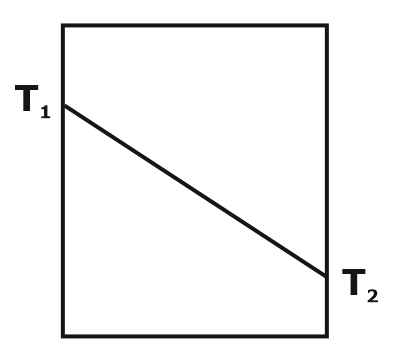
Cylinder:
Sphere:
CONDUCTION WITH HEAT GENERATION:
Conduction with Heat Generation in a Slab
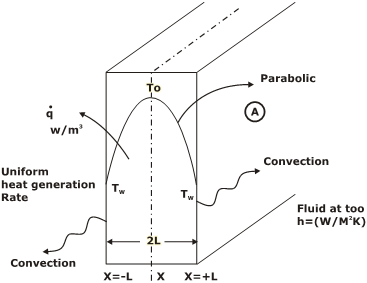
Parabolic Temperature Distribution,
Maximum temperature,
Conduction with Heat Generation in a Cylinder
Maximum temperature,
Conduction with Heat Generation in a Sphere:
Maximum temperature,
where center temperature T0 ,Surface temperature Tw,
CRITICAL RADIUS OF INSULATION FOR CYLINDER:
CRITICAL RADIUS OF INSULATION FOR SPHERE:
No comments:
Post a Comment
Knowing brings controversy